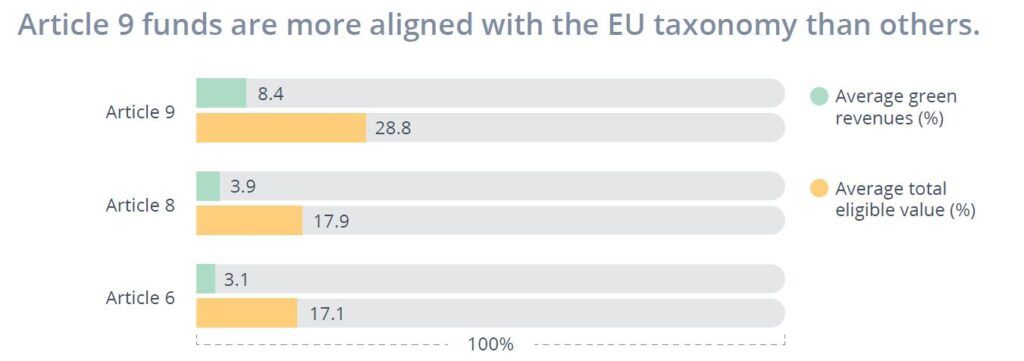Just 7% of funds globally have more than 10% of their revenues coming in from green investments, and they’re unlikely to be Article 8 funds, a study by Clarity AI has found.
Clarity AI looked at a universe of 31,000 equity funds globally. Within that it examined the 2,000 funds with a Sustainable Finance Disclosure Regulation (SFDR) label and found that despite around a quarter of these funds (28%) being classified as Article 8 under the EU taxonomy, Article 8 funds actually have a similar green alignment to the global average: 3.9% green revenues compared with the average 3.6% across the entire universe.
“Investors should not be misled by Article 8 labelling of funds, which will likely not mean a higher share of green revenues than non-sustainable funds,” the report said.
Article 9 funds, however, although making up just 5% of the funds Clarity AI looked at, typically had around 15% of revenues coming in from green investments. Unsurprisingly, funds that mostly invest in utilities have higher alignments when looking into specific sectors, with 25% green revenues. Alternative energy also sees high green revenues.

The report notes that implementing the EU taxonomy can be challenging for investors, due to a mismatch in when data is available and when reporting needs to happen, and because of the constant need to adapt to changing regulation, but overall considers it a ‘pioneer’ in finding a common language and framework for ESG reporting.
“Considering the disparate definitions of and frameworks for sustainability all around the world, we look to the EU taxonomy as a pioneer in setting a common standard to align a large segment of global market stakeholders,” Patricia Pina (pictured), head of product research and innovation at Clarity AI said.
“The EU recognises a key requirement to further the development of the sustainable investment market is ‘access to high-quality sustainability-related data.’ This high-quality data also means moving away from subjectivity and using an objective and fact-based definition of what should be considered ‘green.’, ‘social’, ‘environmental’, and so on. The EU taxonomy gives us a common language that will enable stronger decision making and an acceleration to a more sustainable economy.”








